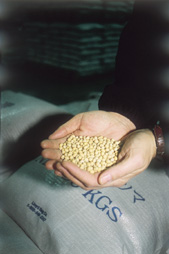
Features
Agronomy
Plant Breeding
Clubroot-resistant canola rapidly advancing
In an all-out effort to control clubroot disease, plant breeders are rapidly closing in on the first clubroot-resistant canola varieties. And that is good news, since approximately 25 percent of the canola acres in Alberta
November 6, 2008 By Bruce Barker
Plant breeders make huge advancements in effort to develop canola resistant to clubroot disease.
 |
| These healthy canola roots show good resistance to clubroot. |
In an all-out effort to control clubroot disease, plant breeders are rapidly closing in on the first clubroot-resistant canola varieties. And that is good news, since approximately 25 percent of the canola acres in Alberta have been reported to be at risk for clubroot infestation, at a potential cost to the canola industry in Alberta of approximately $50 million annually. “We are conducting research looking at both the management of clubroot disease and development of resistant germplasm through introgression of resistant genes from diverse sources,” says Dr. Habibur Rahman, an associate professor and leader of the Canola Breeding and Research program at the University of Alberta in Edmonton. “There is a lot at stake for canola growers.”
Rahman is leading the program that is looking for clubroot resistance. He started the project informally in 2004, without any funding. In 2007 though, the Alberta Canola Producers Commission and the Alberta Crop Industry Development Fund stepped up to the plate with four-year project funding.
In those few short years, Rahman has made rapid advancements. So much that the first clubroot-resistant variety could appear on the market as early as 2011.
Resistant genes found
More than 200 cultivars/lines/land races of different Brassica species and sub-species were collected from different national and international research institute laboratories and gene banks from Asia, Europe and North America. There is no report of resistance to clubroot among Canadian spring canola cultivars. However, clubroot resistance exists in a few European winter canola (Brassica napus) cultivars as well as in its parental species Brassica rapa and Brassica oleracea.
 |
| Dr. Habibur Rahman of the University of Alberta hopes clubroot-resistant canola will be commercialized by 2011. Photos courtesy of the University of Alberta. |
Rahman says the resistance breeding using European winter canola is fairly easy since only one resistant gene is present in winter canola. The downside, though, is that this resistance can break down fairly quickly with the change in the clubroot pathogen. “We have seen this for blackleg disease in canola where the existing genetic resistance is breaking down with the emergence of new pathotypes,” explains Rahman. “The use of a single gene for resistance is a short-term strategy that will let us develop the initial resistant germplasm.”
The longer-term strategy is to use diverse resistant genes that will help to prevent the breakdown of the resistance. Rahman says some non-canola quality rutabaga, B. rapa and B. oleracea have been found to be resistant to clubroot pathogens, and that he will continue to work with these genes that will provide durable resistance to multiple clubroot pathogens.
Rahman is now seeking canola seed companies to commercialize the resistant germplasm. He has at least one seed company that plans on moving the genetic resistance into its breeding program this winter, and others are considering it.
If all goes according to plan, the first hybrids with clubroot resistance will be produced in Chile during its 2008/09 summer season. The first hybrid could enter performance co-op trials in Canada in 2009 and 2010, with commercial seed possibly available in 2011.
That is three short years for a plant breeder who has been working at lightning speed, and three long years for growers who are already struggling to cope with clubroot on their land. And considering that the research funding of $662,200 could help save the industry $50 million, it is also a good return on investment for grower and public research dollars.